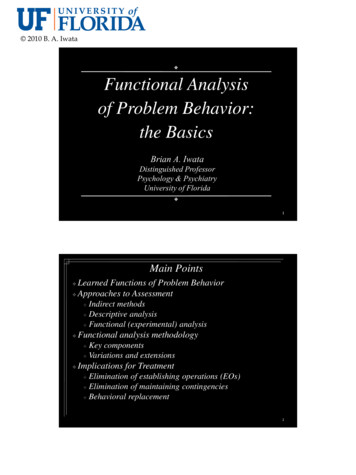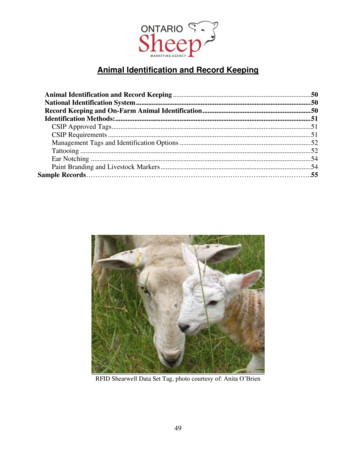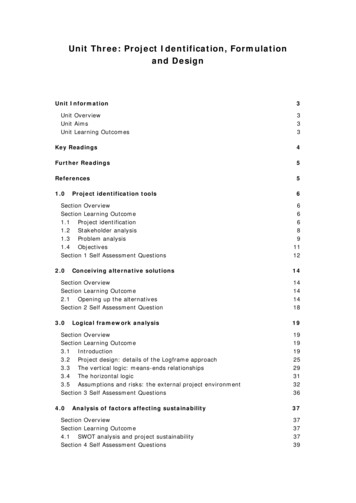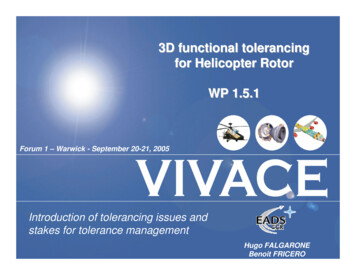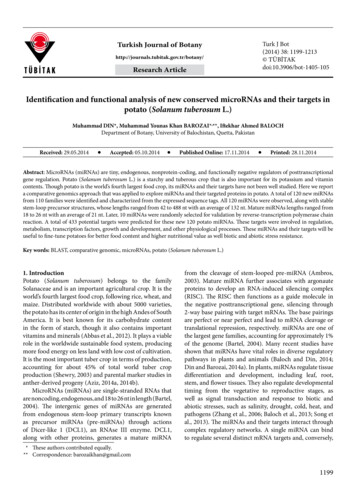
Transcription
Turkish Journal of ch ArticleTurk J Bot(2014) 38: 1199-1213 TÜBİTAKdoi:10.3906/bot-1405-105Identification and functional analysis of new conserved microRNAs and their targets inpotato (Solanum tuberosum L.)Muhammad DIN*, Muhammad Younas Khan BAROZAI*,**, Iftekhar Ahmed BALOCHDepartment of Botany, University of Balochistan, Quetta, PakistanReceived: 29.05.2014Accepted: 05.10.2014Published Online: 17.11.2014Printed: 28.11.2014Abstract: MicroRNAs (miRNAs) are tiny, endogenous, nonprotein-coding, and functionally negative regulators of posttranscriptionalgene regulation. Potato (Solanum tuberosum L.) is a starchy and tuberous crop that is also important for its potassium and vitamincontents. Though potato is the world’s fourth largest food crop, its miRNAs and their targets have not been well studied. Here we reporta comparative genomics approach that was applied to explore miRNAs and their targeted proteins in potato. A total of 120 new miRNAsfrom 110 families were identified and characterized from the expressed sequence tags. All 120 miRNAs were observed, along with stablestem-loop precursor structures, whose lengths ranged from 42 to 488 nt with an average of 132 nt. Mature miRNAs lengths ranged from18 to 26 nt with an average of 21 nt. Later, 10 miRNAs were randomly selected for validation by reverse-transcription polymerase chainreaction. A total of 433 potential targets were predicted for these new 120 potato miRNAs. These targets were involved in regulation,metabolism, transcription factors, growth and development, and other physiological processes. These miRNAs and their targets will beuseful to fine-tune potatoes for better food content and higher nutritional value as well biotic and abiotic stress resistance.Key words: BLAST, comparative genomic, microRNAs, potato (Solanum tuberosum L.)1. IntroductionPotato (Solanum tuberosum) belongs to the familySolanaceae and is an important agricultural crop. It is theworld’s fourth largest food crop, following rice, wheat, andmaize. Distributed worldwide with about 5000 varieties,the potato has its center of origin in the high Andes of SouthAmerica. It is best known for its carbohydrate contentin the form of starch, though it also contains importantvitamins and minerals (Abbas et al., 2012). It plays a viablerole in the worldwide sustainable food system, producingmore food energy on less land with low cost of cultivation.It is the most important tuber crop in terms of production,accounting for about 45% of total world tuber cropproduction (Shewry, 2003) and parental marker studies inanther-derived progeny (Aziz, 2014a, 2014b).MicroRNAs (miRNAs) are single-stranded RNAs thatare noncoding, endogenous, and 18 to 26 nt in length (Bartel,2004). The intergenic genes of miRNAs are generatedfrom endogenous stem-loop primary transcripts knownas precursor miRNAs (pre-miRNAs) through actionsof Dicer-like 1 (DCL1), an RNAse III enzyme. DCL1,along with other proteins, generates a mature miRNAfrom the cleavage of stem-looped pre-miRNA (Ambros,2003). Mature miRNA further associates with argonauteproteins to develop an RNA-induced silencing complex(RISC). The RISC then functions as a guide molecule inthe negative posttranscriptional gene, silencing through2-way base pairing with target mRNAs. The base pairingsare perfect or near perfect and lead to mRNA cleavage ortranslational repression, respectively. miRNAs are one ofthe largest gene families, accounting for approximately 1%of the genome (Bartel, 2004). Many recent studies haveshown that miRNAs have vital roles in diverse regulatorypathways in plants and animals (Baloch and Din, 2014;Din and Barozai, 2014a). In plants, miRNAs regulate tissuedifferentiation and development, including leaf, root,stem, and flower tissues. They also regulate developmentaltiming from the vegetative to reproductive stages, aswell as signal transduction and response to biotic andabiotic stresses, such as salinity, drought, cold, heat, andpathogens (Zhang et al., 2006; Baloch et al., 2013; Song etal., 2013). The miRNAs and their targets interact throughcomplex regulatory networks. A single miRNA can bindto regulate several distinct mRNA targets and, conversely,* These authors contributed equally.** Correspondence: barozaikhan@gmail.com1199
DIN et al. / Turk J Botmany different miRNAs can bind to and cooperativelycontrol a single mRNA target (Lewis et al., 2003).Since 2002, when the discovery of the first miRNAin plants was reported (Reinhart et al., 2002), enormousnumbers of miRNAs have been identified in plantsthrough computational and experimental approaches(Zhang et al., 2006). Due to evolutionary convergenceamong the families of miRNAs in plants and animals(Bartel, 2004), these are valid sources to identify profilesas well as structurally and functionally analyze themthrough bioinformatics and experimental approachesin diverse species (Zhang et al., 2006; Din and Barozai,2014a). Many groups of researchers, using comparativegenomic approaches due to the conserved nature ofmiRNAs, have identified an abundant number of potentialmiRNAs in various species of plants, including Panicumvirgatum (Xie et al., 2010); Gossypium species (Barozai etal., 2008); Arabidopsis thaliana, Oryza sativa, and Populustrichocarpa (Griffiths-Jones, 2004); Brassica (Wang etal., 2012); Euphorbiaceae (Zeng et al., 2009); Phaseolus(Barozai et al., 2013a); 71 different plant species (Zhanget al., 2006); Nicotiana tabacum (Frazier et al., 2010);and Solanum melongena (Din and Barozai, 2014b). Thiscatalog of reported miRNAs suggests that comparativegenomic strategies are highly efficient, convenient, valid,and powerful tools to predict further potential miRNAs inother species (Baloch and Din, 2014).Presently, limited data are available regarding miRNAsin potato, despite its agricultural and economic importance(Griffiths-Jones, 2004; Guo et al., 2007). Recently, Zhang etal. (2013) and Lakhotia et al. (2014) reported 28 and 33miRNA families in potato, respectively. Consequently, thislimited information on conserved miRNAs in potato isinsufficient considering its overwhelming mass productionand nutritional requirements. Therefore, a comprehensivecomparative genomics search methodology using allknown mature and pre-miRNAs of plants was employedto find 120 new conserved miRNAs from 249,761 potatoexpressed sequence tags (ESTs) that belonged to 110families of miRNAs. These new miRNAs were furtherprofiled for structural and functional characterization.In this study, we have also predicted 433 putative proteintargets for the 110 miRNA families in potato.2. Materials and methods2.1. Reference miRNAsA methodology described by Zhang et al. (2006) with afew modifications by Barozai et al. (2008) was applied toexplore the potential miRNAs from potato ESTs. A totalof 3533 known mature plant pre-miRNA sequences weredownloaded as reference miRNAs from the microRNAregistry database Rfam Release 20 (Griffiths-Jones, 2004)and subjected to the basic local alignment search tool1200(BLAST) for alignment with 249,761 publicly availablepotato (Solanum tuberosum) ESTs from a database ofESTs (dbEST, release 130101; http://blast.ncbi.nlm.nih.gov/Blast.cgi), using the BLASTn program (Altschul et al.,1990). Repeated ESTs from the same gene were eliminatedand a single tone EST per miRNA was produced using theBLASTn program against the potato (Solanum tuberosum)EST database with default parameters. Potato (S. tuberosumL.) ESTs with 0–4 mismatches with the mature referencemiRNA sequences were saved as initial candidate miRNAs.2.2. Confirmation of potato miRNAs as nonproteinsequencesThe miRNA validation as nonprotein-encoding sequencesis a crucial criterion for homology-based searches ofnew miRNAs. The pre-miRNAs sequences, identified bymature miRNAs, were subjected to a protein homologysearch. The predicted pre-miRNA sequences, in FASTAformat, were subjected to BLAST against the NCBI proteindatabase using BLASTx with default parameters (Stephenet al., 1997).2.3. Generation of stem-loop structuresThe initial potential candidate potato miRNA sequences,confirmed as nonprotein-coding with 0–4 mismatcheswith the reference miRNAs and representing a singletone gene, were stimulated to generate hairpin secondarystructures. For this purpose, the publicly availableZuker folding algorithm /form1.cgi) known as Mfold(version 3.6) (Zuker, 2003) was applied to predict thesecondary structures. The Mfold parameters were adjustedas per published approaches by various researchers forthe identification of miRNAs in many plant and animalspecies (Bai et al., 2012). For physical scrutinizing, selffolded stem-loop structures with minimum free energy(MFE) of no greater than –18 kcal/mol or lower than orequal to the MFE of the reference miRNAs were preferred.The threshold values from Ambros et al. (2003) wereapplied as a reference to finalize the potential miRNAs.The stem regions of the stem-loop structures were checkedand confirmed for mature sequences either at least 16 innumber or equal to the reference miRNAs’ base pairinginvolved in Watson–Crick or G/U base pairing betweenthe mature miRNA and the opposite strand (miRNA*).2.4. Experimental validation by reverse transcriptionpolymerase chain reactionTen of the newly discovered miRNAs were randomlyselected to be validated by reverse-transcriptionpolymerase chain reaction (RT-PCR). The primers weredesigned using the Primer3 algorithm for the stem-loopsequences of these selected miRNAs from their ESTs(Table 1). Total RNA from the leaves was extracted usingan RNeasy Plant Mini Kit (QIAGEN) according to themanufacturer’s protocol. cDNA was constructed using
DIN et al. / Turk J BotTable 1. The potato pre-miRNA primer sequences for RT-PCR experimental validation. Tenrandomly selected potato miRNAs subjected to expression analysis through RT-PCR are givenhere with primers and product size (bp).Potato miRNAsPrimersProduct size AACCAGCT252the RevertAid H Minus First Strand cDNA Synthesis Kit(Fermentas), as per the supplier’s protocol. A template of120 ng of cDNA was used in the following PCR program:initial denaturation at 94 C for 5 min followed by 35 cyclesof denaturation at 94 C for 35 s, annealing at 59 C for 30s, and extension at 72 C for 35 s, and a final elongationstep at 72 C for 8 min. The PCR products were separatedthrough 2% (w/v) agarose gel.2.5. Identification of miRNA targetsIn the current study, dual approaches were used topredict the potential targets for potato miRNAs. In thefirst approach, the newly identified potato miRNAs weresubjected to a plant miRNA target prediction tool calledpsRNATarget (http://bioinfo3.noble.org/psRNATarget),using default parameters (Dai and Zhao, 2011). The potatomiRNAs that did not produce potential targets throughpsRNATarget were subjected to a secondary approachas described by Barozai (2013). In this approach, themature miRNA sequences were submitted as queriesto the NCBI BLASTn program. The parameters were:database: reference mRNA sequences (refseq rna);organism: Solanum tuberosum (taxid: 4113); and programselection: highly similar sequences (megablast). ThemRNA sequences showing 75% query coverage wereselected and further subjected to RNAhybrid, which is amiRNA target prediction tool (Kruger and Rehmsmeier,2006). Only those targets with confirmed stringent seedsites located at either positions 2–7 or 8–13 from the 5’end of the miRNAs along with the supplementary siteand having MFE of no greater than –20 kcal/mol wereselected. For more stringency, these targets were subjectedto the NTNU microRNA target prediction tool (http://tare.medisin.ntnu.no/mirna target/search#results)toconfirm the RNAhybrid results. Gene Ontology analysisfor the predicted putative targets of potato miRNAs wasconducted on the AmiGO website.2.6. Abbreviationsath: Arabidopsis thaliana, bdi: Brachypodium distachyon,BLAST: Basic Local Alignment Search Tool, bra: Brassicarapa, csi: Citrus sinensis, dbEST: database of ESTs, DCL1:Dicer-like enzyme 1, ESTs: expressed sequence tags, gma:Glycine max, mdm: Malus domestica, MFE: minimumfree energy, miR: mature miRNA, MIR: microRNA gene,miRNA: microRNA, miRNA*: opposite strand of miRNA,1201
DIN et al. / Turk J BotmRNA: messenger RNA, mtr: Medicago truncatula,NCBI: National Center for Biotechnology Information,nt: nucleotides, nta: Nicotiana tabacum, osa: Oryza sativa,ppe: Prunus persica, pre-miRNA: precursor-miRNA,pri-miRNA: primary transcripts of mature miRNA, ptc:Populus trichocarpa, refseq rna: reference mRNAsequence, RISC: RNA induced silencing complex, sly:Solanum lycopersicum, vvi: Vitis vinifera.3. Results and discussion3.1. New conserved potential potato miRNAsA comparative genomic approach along withcomputational and bioinformatic tools produced a total of120 new conserved miRNAs from the analysis of 249,761potato ESTs (Table 2). These 120 newly identified premiRNAs were also confirmed for stem-loop secondarystructures by Mfold (version 3.6) (Zuker 2003). These 120potential potato miRNAs belong to 110 families, namelystu-miR 473, 475, 535 (a, b), 1320, 1446, 1450, 1510, 1870,1873, 1879, 1888, 1918 (a, b), 2090, 2586, 2597, 2608, 2616,2668, 2673, 2678, 2868, 2869, 2939, 3623, 3640, 3948, 3951,3954, 4351, 4993, 4995, 5012, 5019, 5032, 5035, 5038,5039, 5040, 5069, 5150, 5171, 5176, 5179, 5183, 5205 (a,b), 5208, 5210, 5219, 5222, 5223, 5226, 5227, 5234, 5237,5240, 5254, 5261, 5265 (a, b), 5269, 5288, 5301, 5337, 5338,5368, 5492, 5536, 5538, 5630, 5643, 5649, 5657 (a, b), 5721,5722, 5747, 5748, 5749, 5754, 5818, 5819, 6019, 6021 (a ,b),6144, 6145, 6148, 6154, 6156, 6164 (a, b, c), 6252, 6270,6278, 6284, 6287, 6426, 6438, 6439, 6440, 6461, 6468,6476, 7749, 7777, 7785, 7816, 7822, 7825, 7826, 7828,7830, 7835, and 8123 (a, b). A maximum of 3 memberswere found in the stu-miR6164 family; the stu-miR535,1918, 5205, 5265, 5657, 6021, and 8123 families had 2members; and the remaining families had only 1 member.On the basis of current available miRNAs reports, allthese predicted miRNAs were profiled for the first time inpotato. All 120 of these miRNAs were considered as validcandidates after applying the stringent miRNA criteria ofAmbros et al. (2003). The potential miRNAs were justifiedby criteria B, C, and D. According to Ambros et al. (2003),only criterion D is sufficient for homologous sequencesto be confirmed as potential miRNAs in other species.The present study is in agreement with the prior studies(Frazier et al., 2010; Xie et al., 2010; Barozai et al., 2012b,2014). The combination of homology-based investigationand comparative genomics has produced novel andinteresting results in plant genomics. Similar approacheswere used by many groups of researchers to report novelmiRNAs in plants (Frazier et al., 2010; Xie et al., 2010;Barozai et al., 2013a, 2013b).3.2. Characterization of newly identified potato miRNAsCharacterizing the newly identified candidate miRNAsis a conventional step for their validation, as described1202previously (Frazier et al., 2010; Xie et al., 2010; Wanget al., 2012), and MFE is the first significant term ofcharacterization. The pre-miRNAs had MFEs rangingfrom –8 to –224 kcal/mol with an average of –31 kcal/mol.Profound numbers of newly identified pre-miRNAs (53,or 44%) had MFEs within a range of –8 to –21, followed by–22 to –41 (37, or 31%) and –42 to –224 (31, or 26%). Thepre-miRNA lengths of these potato miRNAs ranged from42 to 488 nt with an average of 132 nt; mature miRNAsequences ranged from 18 to 26 nt with an average of21 nt. The majority (61 out of 120) of the miRNAs were21 nt in length, followed by 22 nt (15%), 20 nt (10%),24 nt (7%), 23 (6%), 19 nt (2%), 25 nt (2%), 26 nt (1%),and 18 nt (1%), respectively. These results of potato premiRNAs and mature sequences are in agreement withearlier available data in other plant species (Frazier et al.,2010; Xie et al., 2010; Ji et al., 2012; Barozai et al., 2013a,2013b). The mature miRNA sequences were found inthe form of duplexes in the stem region of pre-miRNAsecondary structures, as shown in Figure 1. Similar resultswere reported by many researchers for various plant andanimal species (Frazier et al., 2010; Xie et al., 2010; Chenet al., 2012; Wang et al., 2012). In potato, newly identifiedconserved mature miRNA sequences showed differencesof 4 nt (36%), 3 nt (37%), 2 nt (21%), 1 nt (4%), and 0 (3%);these match perfectly with the corresponding homologoussource miRNAs. These values are in agreement with theformerly published values in different plants, where themature sequences have a difference of 0–4 nucleotides(Wang et al., 2012; Barozai et al., 2013a; Ghani et al., 2013).For the newly reported potato miRNAs, the average GCcontent was 41%, within a range of 10% to 80%. Fifty-eightout of 120 potato miRNAs sequences were found at the 5’arm, while the remaining 62 were at the 3’ arm, as shownin Figure 1. The secondary stem-loop/hairpin structuresof the pre-miRNAs had at least 16 nucleotides engaged inWatson–Crick or G/U base pairing between the maturemiRNA and the opposite arms (miRNAs*) in the stemregion. A few source miRNAs had less base pairing; theseprecursors did not contain large internal loops or bulges.The relationship between newly discovered miRNAs andknown proteins was an important criterion to validatethe miRNAs as strong candidates. The pre-miRNAs werecompared against the NCBI protein database using theBLASTx algorithm. No homology with known proteinswas found. These results confirmed that our identifiedpre-miRNAs were strong potential miRNA candidatesin potato. Similar results were observed in variouspublications by many researchers (Frazier et al., 2010; Ji etal., 2012). The predicted novel potato miRNAs were alsocharacterized by their organ expression. The majority ofthe newly discovered miRNAs were expressed in tubers(41 out of 120 (34%)), followed by roots and mixed tissues
8656717376231150129177941121291682216867PLPotato miRNAs Source 23333342NMGGGAGTGGGAGTGGGAGTGGGGATG 045.4533.3347.6157.1438.0957.14MSA GC% --- - --- - - ------SLTubersTubersStolonMixed tissuesMixed tissuesTubersTubersCallusRootsStolonLeaves and rootsTubersTubersMixed tissuesMixed tissuesFloral budsFloral budsCallusLeaves and rootsLeavesMixed tissuesRootsRootsFloral budsTubersStolonLeavesRootsOETable 2. Characterization of the newly explored potato miRNAs. PL Precursor miRNA length, MFE minimum free energy, MS mature sequence, NM number of mismatches(represented in red), ML mature sequence length, MSA mature sequence arm, SE source EST, GC% GC percentage, SL strand location, OE organ of expression.DIN et al. / Turk J Bot1203
iR3951stu-miR3951Table 2. 30.00 - ---- - -- --- --- --- TubersTubersPetiolesMixed tissuesTubersTubersLeaves and petiolesTubersTubersLeaves and rootsStolonTubersTubersMixed tissuesCallusTubersMixed tissuesRootsStolonMixed tissuesTubersCallusCallusCallusTubersTubersMixed tissuesLeavesTubersTubersTubersDIN et al. / Turk J Bot
5265a199mtr-miR5261stu-miR5261Table 2. .6338.0933.3347.6133.3338.4642.8530.0042.85------ - -- -- - Leaves and rootsMixed tissuesRootsMixed rsRootsLeavesTubersRootsRootsLeavesWhole plantMixed tissueStem budsRootsLeaves and rootsTubersTubersFloral budsTubersMixed tissuesPetiolesMixed tissuesMixed tissuesDIN et al. / Turk J Bot1205
miR6461ptc-miR6468ptc-miR6476abdi-miR7749bdi -miR7777bdi 4Table 2. .0945.4523.8034.7842.8538.0927.2742.8526.0852.38 - ----- --- ----- ---- StolonStolonTubersRootsLeaves and rootsRootsLeaves and rootsLeavesTubersStolon and tubersRootsCallusTubersFloral budsRootsTubersTubersStolonLeavesTubersTubersStem budsStolonTubersTubersLeaves and rootsTubersMixed tissuesTubersDIN et al. / Turk J Bot
DIN et al. / Turk J BotFigure 1. The newly identified potato miRNA secondary structures. The potato pre-miRNA secondary structures were developedthrough the Mfold algorithm. These structures clearly show that the mature miRNAs are in the stem portion of the stem-loopstructures.1207
DIN et al. / Turk J Bot(17 (14% each)); stolon (9 (7%)); leaves, leaf callus, and root(8 (6.6% each)); floral buds (5 (4%)); petioles and stem buds(2 (2% each)); and leaves, petioles, whole plant, and stolontuber (1 (1% each)). These findings are similar to those ofother reports (Zhang et al., 2013; Lakhotia et al., 2014) andsuggest an organ-dependent expression pattern. The organspecific miRNA expression could be utilized to manageorganogenesis in potato. Due to availability of genome andmRNA sequences, genome-wide searches for sense-antisensetranscripts have been reported (Orlov et al., 2012). In thesame study, 65 (54%) of the 120 novel miRNAs were foundon antisense and 55 (46%) on sense strands of the transcripts.RT-PCR experimental validation was also performed for thenewly discovered miRNAs. Ten randomly selected miRNAswere subjected to RT-PCR validation studies: stu-miR2869,stu-miR5538, stu-miR475, stu-miR1870, stu-miR1873, stumiR2608, stu-miR4993, stu-miR1918b, stu-miR5040, andstu-miR4995. All 10 miRNAs were validated (Figure 2). Thisexperimental confirmation
1199 http://journals.tubitak.gov.tr/botany/ Turkish Journal of Botany Turk J Bot (2014) 38: 1199-1213 TÜBİTAK doi:10.3906/bot-1405-105 Identification and .


